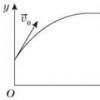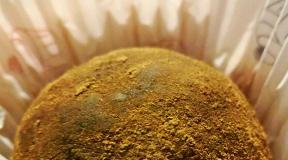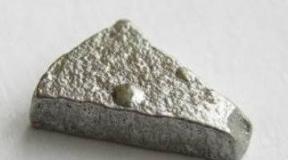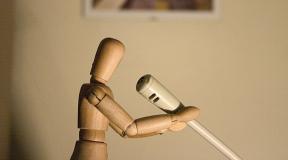Remove the key from the master lock. The key is stuck in the door lock. What to do if the key is on the back of the door
While door lock systems are becoming more and more complex and reliable, the keys, unfortunately, are not becoming stronger. What to do if the key in the lock is broken? Many are in a hurry to remove the blocked element and install a new mechanism, but there are more humane ways to preserve the integrity of the lock.
Reasons for key failure:
- gradual wear of the metal of the key and parts of the locking mechanism as a result of prolonged use;
- improper operation of the door (inserting a key from another lock, excessive mechanical force, sudden slamming of the door);
- low quality key blanks or poorly made duplicates.
If the key breaks in an intermediate position
The key can only be removed from the door when it is locked in its initial or final position. How to remove a broken key from a lock when it is stuck in an intermediate position?
- First of all, you should spray WD-40 aerosol (in extreme cases, any lubricant will do) inside the core.
- Try tightening the key using a piece of key or a screwdriver.
- If this method does not work, you can remove the key only after removing the pins. Drilling out the pin holders is not very difficult, but not everyone can put everything back together - it’s easier to change the cylinder.
How to remove a broken core key from a mortise lock
In such locking mechanisms, you just need to carefully remove the side cover. After the fragment has been removed, the lock is installed back in the door and continues to function. However, to prevent the situation from recurring, it would not be superfluous to lubricate its internal mechanism.

How to remove a key if part of it is protruding from the keyhole
- The most common way to remove a piece of debris that is stuck in a lock is to snag it with pliers. This is a very delicate work, which includes the process of securely grasping the key and further manipulating it: you should slightly swing the key and gradually pull it towards you. Considering that it is possible to hook only a minimal area of the key, this is quite difficult to do. It also happens that it is not possible to hook a fragment with pliers due to its small size, then try to arm yourself with a thinner tool - tweezers.
- You can get the key out of the door quite easily and quickly if you drill a hole in the end of the stuck piece and screw in a self-tapping screw. Then you need to spray WD-40 into the well and, carefully shaking it, use pliers to pull out the screw with the key that is stuck.
- There is a way to remove a broken door key using a pair of well-sharpened awls. Each of them must be inserted into the keyhole on both sides of the fragment. After this, you should firmly grasp and squeeze the fragment, and then pull the awls towards you, dragging the fragment forward. Instead of an awl, you can use a regular long sewing needle.
- Many craftsmen advise trying to remove a broken key using a file (blade) for a hand jigsaw. The file must be inserted with the teeth up into the keyhole, and then carefully move it until the teeth pry up the fragment. As soon as the tool securely engages with the key, you need to smoothly, without jerking, pull it towards you along with the key.
- The most accessible and quite effective method is the method of extracting the door key using a fishhook. If it is hardened, it must be heated and bent, and then the tip with a notch must be inserted into the well. As soon as the fragment is caught, you need to pull it towards you. Repeated repetitions guarantee a successful outcome of this operation; moreover, a hook cannot disable the secret of the lock.
- If the broken part of the key is not too deformed, you can buy superglue and try to connect the parts of the key. To do this, glue is applied to the accessible part of the key, then it is inserted into the lock and sharply pressed against the broken part. After waiting a little for the glue to harden, you need to smoothly remove the glued key. Be sure to keep in mind that doing this is very dangerous: the key may not “grab”, and the glue will smear the internal cavities of the well and ruin the secret mechanism of the lock. Naturally, even if the extraction operation is successful, this key should no longer be inserted into the lock.
- You can use a powerful neodymium magnet to remove the broken key. Of course, this is only possible if the key is made of a material that interacts with magnetic fields.
- The option of extracting the key using a steel wire is relevant only when there are no tools available. Thin steel wire is easiest to find in such conditions. It is also inserted into the hole in order to hook the fragment and remove it. It will take a long time to do this, and achieving results will not be easy.
Despite the numerous ways to remove a broken door key, it is very difficult to do, and the expected result is not always achieved. You should not repeat unsuccessful attempts many times, so as not to aggravate the situation. It is better to contact a lock repair service. In this case, the visible part of the broken key must be saved in order to show it to the master. An experienced employee will remove the key if possible, or carefully remove the door lock when nothing can be done.
A reliable way to remove a piece of metal from a lock is to disassemble the structure All sorts of pleasant and unpleasant surprises happen in our lives. While pleasant events bring joy and satisfaction, unpleasant ones can lead to confusion, anger, irritation or despair. Probably, many people have experienced events related to door locks, or more precisely, their breakdown. So, not everyone can answer the question: “How to remove the key from the lock if it is broken.”
The key in the lock is broken: reasons
Difficult situations can cause panic, which can disrupt the thought process, lead to stress and the inability to find a way out of the situation. To prevent this from happening, you need to prepare in advance for a situation that can happen to anyone. You can get the key, but subject to complete calm and prudence.
The main reason for the breakdown is that the key may be made of low-quality material
Some careless actions and unsuccessful attempts can lead to the fact that the fragment not only remains in the castle, but also completely ruins it.
It is almost impossible to open a door with a key stuck in the lock. It is important to know the reason why the key broke, and it would also be good to know the structure of the lock mechanism. The reasons why keys break can be very different.
Why the key may break:
- If the key is of poor quality, it can easily bend and then break. When purchasing keys, it is important to pay attention to the material from which they are made, as well as the composition of this material.
- The lock and key may simply wear out. This means that the locking device in the lock may fail. The inside of the lock can become dusty and dirty. If the mechanism has not been cleaned in time, the key in the lock will move slowly and may even break.
Sometimes a key breaks due to a simple human factor, when the key is inserted halfway into the lock and pressed. Of course, when a breakdown has already occurred, you should not immediately find out its causes, you need to start solving the problem. Today you can find a solution on the Internet, but sometimes situations turn out to be so stressful that you only need to act according to a pre-planned plan.
Key stuck in door lock: what to do
On the Internet you can find many articles about how to easily, quickly and easily remove a broken key. However, in practice everything turns out to be much more complicated. When the key becomes sharp, it gets stuck in the lock - it is not so easy to get it out.
If the key is stuck in the lock, you can try spraying oil (preferably machine oil) into the slot, and then move the key in any way
For example, there is an opinion online that the key can be easily pulled out of the lock using glue - in fact, this is a myth.
This method not only will not help remove a key stuck in the door lock, but may also result in the second part of the key also remaining in the keyhole. When choosing a key removal method, it is also important to remember the likelihood of breaking the lock. Today, locks are expensive, so it is better to choose a neat and safe method for removing the key.
Key extraction options:
- Disassemble the lock. Careful handling of the lock will prevent it from being damaged while removing the key.
- Use a self-tapping screw. A thin drill or self-tapping screw can carefully remove the key from the hole. It is important to accurately hit the stuck key with the drill.
- Use pliers. If the key protrudes from the hole, you can grab it with pliers, but under no circumstances should you pull the key too hard.
When trying to get the key, it is important to remember not to damage the secret mechanism of the lock. It is important to understand how deep the key is and use methods that will actually help solve the problem, and not make it worse. Removal methods may be different, but the essence is the same - you should not pull the key with force, as this will only damage the lock mechanism.
How to open a door if the key is broken
On many Internet sites, users ask the question: “What should I do if I can’t get a broken key out of the lock?” This situation is familiar to many, when it becomes impossible to get into or out of an apartment. There are ways in which the key can be easily removed, and the door can be opened within ten minutes.
If you don’t panic and approach the issue calmly and competently, you can cope with this problem
If the key is left in the front door, the first rule is not to panic, do not start acting rudely and aggressively.
I tell many stories that the key turns before it breaks. Many people try to press it harder in the hope that it will help. But such actions often lead to the key breaking.
Key extraction options:
- Using an awl. They take two tools, try to hook the key with them and gently swing it from side to side. Before the operation, it is better to lubricate the keyhole with machine oil or an anti-corrosion compound.
- A jigsaw file. It will help you cut off a piece of the key so that it is convenient to grab its tooth. If this is possible, you need to drag it slowly, slightly rocking the fragment from side to side.
- Using a blowtorch and brass tube. A brass tube is placed on the fragment, it is heated and the key is removed.
- Fishing hook. This tool allows you to remove the key without damaging the lock core. They are trying to hook the fragment with a hook. This method requires patience.
The success of all key extraction operations is also influenced by the type of keyhole. If you cannot get the key yourself, it is better to seek help from specialists - they have extensive experience in this matter. Removing the key and being nervous is not the best option.
Options: how to knock a lock out of a door
Sometimes it happens that no methods help open the lock. Then the most important way to quickly open the door is to knock the lock out of the door. This will not be easy to do if you don’t know how to act. This method will help those who are in a hurry and cannot wait for a specialist to come to the rescue.
You can only get into your home by using brute physical force.
Usually men knock down doors with their shoulders - this is a good way, but only for those who have sufficient strength. After three attempts, you shouldn’t hope that the lock will give in.
You can knock out the lock with a strong kick. But here it should be noted that it is necessary to hit exactly in the place where the keyhole is located. The impact force must be maximum, otherwise the lock may remain in place.
How to knock out a lock:
- Use a “roll up”;
- Master key;
- Bumping.
Opening a door without a key is very difficult. If you have time, it is better to seek help from a specialist who, using special and professional tools, will open the door so as not to damage either the lock or the door structure. If a key is stuck in the lock, you must first try to remove the lock cylinder. If this fails, then the lock on the door of the apartment or house will have to be broken.
If the key in the lock is broken, how to get it out (video)
Many people have found themselves in a situation where the key in the lock breaks. Part of the key remained in the hole, which did not allow opening the door and entering the room. When a person has time, he can call a door opening specialist. But if there is no time, you need to act yourself. It's important not to be nervous. Knowledge acquired before such a situation occurs will allow you to cope with a stressful situation. If the key breaks, first of all there is no need to remove it from the well aggressively. You need to try to grab it, and, swinging it slightly, pull it out.
Similar materials



A situation can happen to every person when, in the process of closing or opening a lock, the key suddenly breaks and remains inside. Most people don't know how to remove a broken key from a lock, so it becomes a real problem. The situation is really not a pleasant one, but there is no need to panic - if you approach this issue competently and calmly, you can recover the wreckage and avoid any losses. If the case is very severe, then with the right approach only the cylinder changes, but not the whole lock.
Why do keys break?
There are several reasons why keys break inside an element. The first is worn-out internal lock mechanisms, as well as a worn-out key. Nothing can be done about this - it is natural during operation. Keys also break due to dirt and debris getting into the secret mechanism of the lock. Often various foreign objects penetrate there. Often the key can break if they try to open the lock incorrectly - for example, it is not inserted into the hole completely, or they mistakenly try to open the lock with a different key.
Often a part can get stuck in the lock, and they try to turn it by force, using a handy tool. Naturally, metal breaks under the influence of pliers, hammers or steel pins. And finally, keys can be made from low-quality materials. Manufacturers often save money by using inexpensive raw materials.
Soft methods
So, we have a broken key in the lock and we need to get it out somehow. There are two ways to solve this problem - radical methods and more gentle methods. Often keys break due to dirt - the lock mechanism is literally clogged with debris.
In this case, you can clean the mechanism from dust and also lubricate the lock. Any available lubricants are suitable for this. You can use the popular WD-40, motor oils, silicone, lithol, whatever you have on hand. In a pinch, even sunflower oil will do.

It is convenient to lubricate locks with a syringe. The core needs to be washed. You may have to do this more than once until all the dirt comes out. Next, without sudden movements, you need to try to pull the fragment towards yourself with your hands or an improvised tool (for example, pliers).
We use oil
How to remove a broken key from a lock using oil? The mechanism is generously lubricated, and then, using tweezers or pliers, the protruding fragment is easily and safely pulled out. But this is true if there is a part of the key sticking out of the lock that you can grab onto.
Jigsaws
This tool is considered one of the most effective and popular for solving such problems. In the process you will not need a whole jigsaw, but only the cutting part. The jigsaw blade must be inserted into the cylinder or core of the lock under the key. Next, carefully turn the tool so that its teeth are at the top. This way you can pick up a piece of the key and, using its contact with the teeth, pull it out of the mechanism.
Self-tapping screws
If you don’t have a jigsaw at hand, you can also use self-tapping screws. They are much easier to find. But this method is only suitable for fairly thick fragments. Using an electric or hand drill, drill a small hole in the key at the break point. Then a self-tapping screw is screwed into it. Then, after minor effort, the key can be pulled out.
Vibrations
Here's how to remove a broken key from a lock using the vibration method.

But it is effective only for disk locks. The first step is to lubricate the lock pins and then move them into the same position as the broken key. Then, on the other side, they knock down the lock with a hammer - due to vibrations, a piece of the key may come out. All that remains is to grab it with any suitable tool and pull it out completely.
Awl
Experts recommend a tool such as an awl. Locks are different, and the keys to them are different, but in most cases it is still possible to insert two thin awls into the gap between the key fragment and the hole. Then, by rocking, you can remove the stuck piece.
Level
But how to remove a broken key from a lever-type lock? The keys to these elements are usually a cylindrical pin with various bits. You can remove the fragment using a brass or copper tube. The most important thing is the diameter of the tube. It must be suitable. The length is selected based on the part of the key that remains in your hands. The diameter of the tube should be such that it fits onto the lock pin with great difficulty.

Having expanded the end of the pipe by heating in any available way, it is forcefully put on the fragment. When the part has cooled down, you can try to remove it from the lock hole.
Neodymium magnets
Today these products have become very popular. They are selling very actively. Of course, the effectiveness of this method is low. But the power of the neodymium magnet is quite sufficient to remove the broken key from the cylinder.
What to do with padlocks?
They break down more often than their internal counterparts. This can easily be explained by the fact that the mechanisms are constantly in contact with an aggressive external environment. In addition, various vandals and hooligans have access to them. Let's see how you can remove a broken key from a padlock.
The first step is to knock on the lock, but it is important not to touch the handles. Vibrations can cause jammed parts to move again and the key to fall out. You can also sew oil into the slits. Due to this, friction will be reduced, and rust will not interfere with the operation of the mechanism as much. Also, due to lubrication, the springs will be able to straighten if they were compressed. Sometimes corrosion can penetrate into every element of the mechanism and the risk of breaking the key becomes especially high.

You can also dip the lock in a bath with any active chemical. Some use gasoline, diesel fuel, kerosene, acetone, weak acid solutions, vinegar essence, Coca-Cola, Sprite. All these substances can affect corrosion products. But you need to remember that it is impossible to get results right away - it takes time. Sometimes the process can last from several hours to a day or more.
In most cases, after exposure to chemicals, such a problem as removing a broken key does not arise. The castle will give up the fragment. But if the mechanism does not want to give in, then you should try heating. If the product is made of stainless steel alloys or plated with nickel, then even an open flame will do. If the part is coated with polymer or painted, it cannot be heated with fire - it must be treated with boiling water.
Acts radically
We considered soft and gentle methods for removing the key fragment. Now let's see how to remove a broken key from a door lock if all else fails. You need to get the key along with the larva. If the door is also open, then everything can be done quickly and accurately. It is enough to unscrew the bolts of the lock at the end and pull it out. If it consists of a block and a base - a cylinder, then the larva is simply released. And to replace it, a new one is purchased for a lock of this type.

Next, the larva can be drilled out with a drill. These products are made of soft and light alloys and will simply fall apart under the influence of drills and drills. Then it is important to completely remove the remaining key fragment and cylinder from the lock. This is convenient to do with screwdrivers or wire hooks. After all this, it is recommended to completely disassemble the lock to thoroughly clean it and replace the cylinder.
Here's how to get a broken key out of a door lock using more barbaric methods. But even if professionals who perform autopsies work, the element will still have to be changed. They use the same tools - drills, screwdrivers and the like.
Prevention
In order to avoid getting into unpleasant situations when keys break and remain in the locks, it is necessary to take certain actions. The element is thoroughly cleaned at least once a year by rinsing with gasoline or kerosene. You also need to remember to lubricate the locks with silicone lubricants - it will not only reliably protect the metal from corrosion, but will also not collect dust.

A special protective cover can be made over the larva. If the lock begins to jam, it is better to replace it before the key begins to get stuck in it. If the mechanism jams even slightly, this will continue. And then you will have to think about how to get the broken key out of the lock.
Keys must be handled with care. There is no need to use them like a mechanic's tool. Don't slam the door. You can also install a second lock for added security. It is recommended to make duplicates only in trusted workshops.
So, we found out how to get a key piece out of a lock using different methods.
The problem of a broken keyhole is a common occurrence. Most often this is due to wear of the lock, shifting of the latch and jamming of the tongue. In addition, sometimes the cause of the malfunction is a key or any other foreign object stuck in the well. What to do if the lock fails? From this article you will learn how to open a door if the lock is jammed and what to do if the key breaks in the lock.
Why is this happening?
First of all, you need to establish the reason for holding the door in the locked position. To do this, you need to try to pry the blade with a screwdriver in different areas and try to move it. Only after such manipulations will you be able to understand what the problem is with the locking mechanism.
Some simple mechanisms can even be opened with a knitting needle.
Separately, it should be said about interior doors, which also tend to slam shut and their lock can also jam. Of course, opening it is not as difficult as the entrance, but you still need to try. The lock mechanism in an interior door is usually very simple and can be pryed off with a screwdriver, helping yourself with pliers. You can try to insert a card into the slot to touch and pull the tab to the side. Try to have such items in the public domain, because often small children close the door behind them or someone may become ill in the bathroom.
VIDEO: How to open a lock if the door slams
The latch has moved: how to solve the problem?
If the locking mechanism is equipped with a latch, then sometimes it may happen that it does not tighten when the bolt is pressed. When you push the door to close it, you can cause the latch to move a couple of millimeters into the groove.
It would seem that these are 1-2 mm? However, this distance is quite enough for the locking latch to “settle” tightly into the core of the mechanism.
It’s quite possible to solve this problem yourself:
- insert a screwdriver into the gap between the blade and the shut-off valve;
- press the door.
Lock tongue jammed
When the door is not closed by the bolt mechanism, but all attempts to open it have not been successful, then this problem is easily explained: the lock latch has jammed. What to do if the door lock is jammed? First of all, you need to try to find a flat-bodied, flexible and at the same time durable object: a kitchen knife, a metal ruler, or even a plastic card, which is present in almost all of us in our wallets.
How to open a jammed lock? To solve the problem, you must adhere to the following recommendations:
- We insert the card between the door and the locking mechanism in the place where the locking latch is located.
- We tilt our “weapon” towards the door handle and lightly press on it. At this point you should feel the card sliding along the inclined part of the latch.
- Next, you need to press the object away from you so that it forces the latch away from the locking mechanism. When performing these actions, you need to press the door leaf or pull it towards you. If the door opens towards itself, then you need to pull it, but in the case when it opens away from you, you need to push it accordingly.
The main thing is to be able to move the tongue
- When the latch does not have a beveled part, the “tool” should be inserted from above and tilted slightly obliquely, trying to reach the inside of the locking device. At the same time, it takes a lot of effort to press the latch. Therefore, if you belong to the fair half of humanity, then enlist the support of a strong man.
If you do everything correctly and do not deviate from the above instructions, then literally within an hour you can get home.
Broken lock: how to unlock the door?
If, after examining the door, it turns out that the door does not unlock due to a malfunction of the locking mechanism, then in order to solve the problem, you need to get to the “core” of the structure.
This will not be easy to do. The most primitive in terms of disassembly is the English castle. To do this, you just need to drill out the cylindrical part of the mechanism. Next, you need to remove the latch cylinder and hook the drive device with a strong hook. Such movements will provoke the movement of the crossbars into the body.
The cylindrical part can be knocked out. To do this, we rest a strong object of identical size against it and hit the latter with a hammer or a small sledgehammer.
If a lock of a different configuration breaks on a door, then solving the problem involves several complex steps. When the handle is attached to the door body using external bolts or self-tapping screws, they need to be unscrewed using a screwdriver or any other object that fits the cross-section of the fastening hardware: a knife, a manicure file, etc.
After the handle is removed from the canvas, you need to take a thin object, like a knitting needle or a ballpoint pen, feel for the locking mechanism with it and press on it, while trying to unlock the door.
If such manipulations do not help solve the problem, then the breakdown may be due to jamming of the crossbars. In this case, it will be extremely difficult to repair such damage yourself, and if you are not confident in your own abilities, then it is better to seek help from a qualified specialist.
Or you can try to solve the problem yourself:
- First of all, you need to dismantle the decorative platband that covers the door holes.
- Next, using a hammer and chisel, remove that part of the mechanism in which the mortise counter plate is located.
- If the door leaf opens towards you, then opening it after such manipulations will not be difficult. Whereas when you open the door away from you, you will have to completely ruin the box. But at the same time, you have a great chance of keeping the entire door panel intact.
Before you start “saving” the situation, set your priorities. What is more valuable to you, a lock or a door leaf? Experts recommend leaning towards the most expensive item. Replacing a lock, which is a priori cheaper than a door, will be more profitable than replacing the entire door leaf as a whole.
There is another way to open a door if the locking mechanism is broken. If there is a gap between the shut-off valves and the door, then you can simply cut off the crossbars with a grinder and a cutting wheel. If the locking device on an interior door is broken, and no measures help open them, then in this case the hinges are sawed off.
The key is broken in the lock

What to do if the key is broken in the door lock? First of all, you need to remove the fragment. If it protrudes out a little, then pliers are used to remove it. When the fragment “sits” inside, it will be more difficult to resolve the situation.
In this case, experts recommend using a thin jigsaw blade, which is inserted into the hole from the bottom side with the teeth facing up. Next, you need to turn the blade to hook the fragment; you need to carry out such manipulations until you can remove the jigsaw blade along with the broken part of the key.
Now all that remains is to use the second key. If you fail to get the fragment in this way, then radical measures will be required:
- unscrew the lock;
- remove the fragment;
- drill out the central part;
- we take out the lock cylinder.

What to do if the key is on the back of the door?
Many young parents encounter this problem when the child locks himself from the inside and does not pull out the key.
There is no need for drastic measures. It is necessary to slip a newspaper into the gap between the door and the floor surface. Next we take a pin, nail or knitting needle and try to push the key out. All that remains is to wait for the moment when it falls onto the prepared canvas, pull it out and unlock the door.
I would immediately like to note that such manipulations are only possible with an interior door when the key is not turned and there is a hole on both sides of the door.
Now you know how to open a jammed or broken lock on an entrance or interior door. And if you follow the above recommendations, you will get into the room within the near future.
VIDEO: How you can easily pick any lock
No one is immune from such an unpleasant situation when, when opening or closing a door, the key breaks off and half of it remains in the lock. If the key in the lock breaks, do not panic - in most cases, the broken piece can be pulled out and the door opened. To do this, you can turn to specialists, but there are also ways to solve the problem yourself - this is especially important when there is no time to wait for a specialist.
Causes of failure
 Despite the fact that the keys are made made of metal, they break easily in locking mechanisms in the following cases:
Despite the fact that the keys are made made of metal, they break easily in locking mechanisms in the following cases:
- an attempt to turn a jammed mechanism;
- material wear;
- using a key from another lock;
- the mechanism is clogged with debris or a foreign object has entered it.
First, try “soft” ways to remove a broken key from a lock.
To begin, lubricate the core of the larva with any available means - grease or oil, preferably machine oil, but if this is not available, even sunflower oil will do. It is convenient to do this with a syringe. After dripping several times, wait 10-15 minutes for the oil to spread inside the mechanism. After this, take tweezers or thin pliers and try to remove the protruding fragment. Assess how deeply it is embedded, and keep in mind that you should not use force - this can damage the lock and complicate the task.
The next way to get the larva out of the lock together with a key is one of the most popular. To do this you need to use a jigsaw file. This will require attention and caution, because the blade must be slipped under the key, so that the slope of the teeth points in your direction. This way you can pick up the fragment and use the teeth of a file to pull it out.
If you don’t have a jigsaw at hand and the key is wide enough (for example, for a garage door), then you can use a self-tapping screw to remove the fragment. To do this, drill a small hole at the fracture site, insert a self-tapping screw into it and carefully pull the fragment out.
If the key breaks in the padlock, you need to insert two small awls into the holes and, swinging them, remove the fragment. You can also use neodymium magnets, with which you can try to remove the fragment from the larva.
 There are several options for how to open the door if the lock is broken. The task is not easy, so if you do not have sufficient skills, you should turn to specialists. You can open the apartment only by breaking the lock or dismantling the door.
There are several options for how to open the door if the lock is broken. The task is not easy, so if you do not have sufficient skills, you should turn to specialists. You can open the apartment only by breaking the lock or dismantling the door.
If the door is not very heavy and you have little time, then the most effective way is to simply knock it down. An even more radical method, which is suitable for an iron door, is to cut it off its hinges using a grinder. If it is not installed in the door frame, then you can use a crowbar to try to lift it and remove it from its hinges.
The gentlest way is to get to the lock mechanism; to do this you need to drill a hole above it with a drill and pull out the cylinder. Not so much effective, but a working method on how to remove the larva without any special means at hand: insert the tip of a Phillips screwdriver inside the mechanism and slowly turn it.
If you did not have time to slam the door before the key broke, the cylinder can be removed from the end using a screwdriver.
Preventive measures
To avoid such misunderstandings, it is necessary to carry out simple prevention:
- Once a year or more often, lubricate the lock with special oils.
- Try not to slam the door to avoid wear on the mechanism.
- External street locks should be protected from external influences such as debris, moisture and wind.
If you were unable to open it yourself, contact the service professionals. This way you will quickly get into your home, and, most likely, you will not have to change the lock, much less the door.
Attention, TODAY only!






















